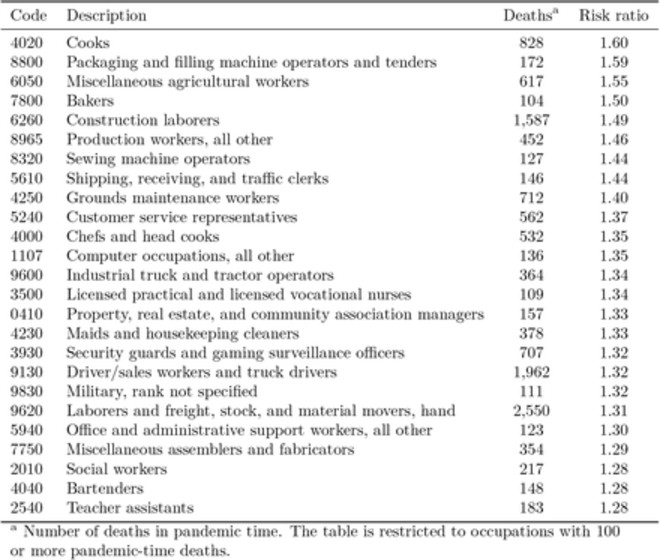[ad_1]
(CBS Local/CBS SF)– A University of California, San Francisco study of the jobs at most risk for death from COVID-19 shows line cooks, machine operators, agricultural workers, bakers, and construction laborers at the top of the list.
The study looked at occupational sectors associated with high excess mortality during the pandemic, with a focus on racial and ethnic groups disproportionately affected by COVID-19. According to the study, in-person essential work is a likely venue of infection and needs to be addressed with strict enforcement of health orders for workplace settings and worker protections.

(UCSF/medRxiv)
Researchers estimated the excess mortality among Californians 18-65 years old by occupational sector and occupation. Since the beginning of the pandemic, these working age adults saw a 22% increase in mortality compared to historical periods. However, food and agricultural workers saw a 39% increase in excess mortality during the pandemic, the highest among all sectors.
In addition, Latinos saw a 36% increase in mortality, and Latino food/agriculture workers saw a 59% increase in mortality. Black Californians saw a 28% increase in mortality, and Black retail workers saw a 36% increase. While Asian Californians saw an 18% increase in mortality, Asian healthcare workers saw a 40% increase.
In comparison, excess mortality among White working-age Californians increased by 6% during the pandemic, and a 16% increase among White food/agriculture workers.
Researchers noted Latino, Black and low educational attainment populations face unique occupational risks because they may disproportionately make up the state’s essential workforce and because essential workers often cannot work from home. Due to historical structural inequities, low-wage essential workers are also more likely to live in crowded housing, resulting in household transmission.
“In-person essential workers are unique in that they are not protected by shelter-in-place policies. Indeed, our study shows that excess mortality rose sharply in the food/agriculture sector during the state’s first shelter-in-place period, from late March through May; these increases were not seen among those working in non-essential sectors. Complementary policies are necessary to protect those who cannot work from home,” the study’s authors wrote.
These can and should include: free personal protective equipment, clearly defined and strongly enforced safety protocols, easily accessible testing, generous sick policies, and appropriate responses to workplace safety violations.”
The study said vaccine distribution plans need to prioritize in-person essential workers in order to reduce the excess COVID mortality.
Earlier this week California announced a number of changes to the COVID-19 vaccine delivery system to give the state more control in expediting vaccinations after studies showed it lagging behind all other states in its vaccine rollout.
Last week, the Bloomberg COVID vaccine tracker showed California was last in percentage of vaccines administered, with only 37% of the vaccines distributed being injected. While California has administered more than 1.6 million vaccines — the most of all states — it has received about 4.4 million doses, according to the tracker.
The UCSF researchers said their analysis is among the first to identify non-healthcare in-person essential work as a predictor of pandemic-related mortality.
“Shutdown policies by definition do not protect essential workers and must be complemented with workplace modifications and prioritized vaccine distribution,” the authors said. “If indeed these workers are essential, we must be swift and decisive in enacting measures that will treat their lives as such.”
[ad_2]
Source link